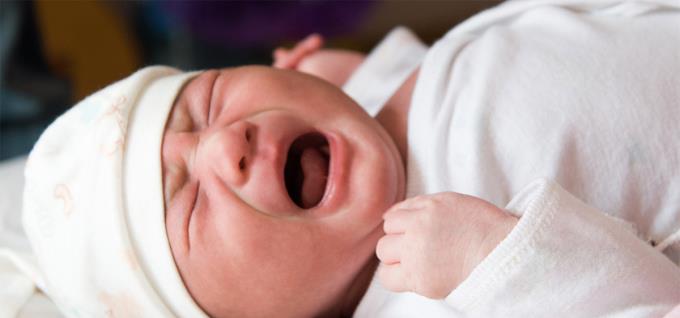Ways to determine an infants caloric needs

Learn how to determine your baby’s caloric needs, including the calories in breast milk and formula, to ensure your infant gets the right nutrition for healthy growth.
Anal leakage in babies is a problem that many parents worry about. If not treated properly, the disease can lead to many dangerous complications, adversely affecting the physical and mental development of children.
Let's find out the causes and treatment of an anal fistula in a newborn in the following article.
The anus is the last organ of the digestive system, located between the buttocks and the place where stool is removed from the body. An anal fissure is an abnormal "tunnel" that forms from the anal canal to the skin near the anus. This fistula can also come from the anal canal to other organs such as the vagina or urinary tract .
An anal fissure is often confused with an anal abscess because both have similar symptoms. In essence, these two diseases are two different stages of an anal sinus infection. In which, anus abscess is an acute phase, while anus fistula is a chronic stage.

Depending on the severity, a newborn anal fistula can be classified into the following categories:
Complete leakage : A fistula condition that goes through from the inside to the outside of the anal skin.
Incomplete leakage : A leakage phenomenon that has only 1 leak. The hole may be inside or outside the anus.
Complicated leakage (horseshoe fistula): The leakage is zigzag in many nooks and crannies, with many openings outside the skin.
Simple leakage : Is a straight, short leakage phenomenon, there are not many nooks and holes such as complicated leakage.
Leakage in sphincter (shallow fistula)
Leakage of the sphincter (fistula on the sphincter)
Leaks through sphincter
A newborn's anal fissure can have many different causes. Many children have an anal fistula due to congenital abnormalities in the anal glands. It is these abnormalities that allow feces and foreign bodies to accumulate inside the gland, causing infections and anal abscesses.
The untreated abscess ruptures, forming the connection between the anal canal, abscess cavity and skin. After a few weeks, this connective zone will form fissures out of the anus or nearby areas.
In addition, anal fistula in children can also be caused by constipation for a long time, strong straining when defecating, causing cracking, tearing the anus. In addition, a small number of children with congenital anal fissure, the fistula occurs without an abscess or pus.

Symptoms of a newborn anal fistula vary, including:
Swollen, stiff, and pus may appear in the skin around the anus
There is an itchy sensation in the anus
Prolonged anal pain
The skin around the anus oozes yellow or pus discharge, has a fishy odor, discomfort, the diaper bottom is always dirty
Pus or bloody bowel movements
Frequent fussy crying and quitting feeding
High fever due to infection
If not treated promptly and properly, the disease can cause many dangerous complications, including:
This is the most common complication of an anal fistula in a newborn. The fistula will have an ulcer, discharge of pus, and the skin around the anus will also be swollen, causing the child to feel extremely uncomfortable and painful.
A fissure that is left untreated or untreated can allow new fistula to develop. When combined, the old and new fistula will cause a multicast anal fistula. In particular, these complex fistulas tend to spread to other organs in the body such as the bladder, rectum and urethra, making treatment more difficult and complicated.
Long-term fissure can turn into a chronic form, often recur, and make it difficult to finish treatment.
An overgrowth of fistula and chronic inflammation is one of the causes of anal cancer cells .

An anal fissure in a newborn is a dangerous health problem. Therefore, parents need to bring their child to medical facilities immediately if the child shows the following abnormalities:
High fever
Abdominal pain persists and shows no signs of remission
Unusual defecation
Red pain, swelling, bleeding or discharge in the area near the anus - rectum
Bloody, mucus, or pus stools that are dark red or light in color, mixed with fluid, pus, and blood
Persistent vomiting
Before treatment, the doctor will conduct observation and symptom examination to determine the degree of anal fistula. Usually, newborn babies will not need the primary anal fistula and abscess diagnostic tests. Imaging tests such as fistula, pelvic tomography, or magnetic resonance imaging are only done in cases of an anal fistula that is complicated by a secondary cause.
Anal fistula surgery is rarely indicated in infants unlike adults. Instead, topical remedies including anal hygiene and anal immersion will be preferred during treatment.
The anal immersion solution is usually Povidine -iod diluted in warm water. The sick child should soak the anus after each bowel movement and after cleaning the anal area. Soak for about 5 minutes or more each time.

In the case of a child with a swollen abscess and pus accumulation, the doctor will make an incision to drain the pus out. Before the pus incision, your baby will be anesthetized in place. After the incision, parents will be instructed how to separate the edges of the wound after each diaper change or anal hygiene for the child.
If the conservative treatments are not working, your child may need a fistula surgery.
Home care is extremely important in the treatment of an anal fistula in a newborn. Good care will help improve recovery efficiency and shorten healing time. Therefore, when a child has an anal fistula, parents need to pay attention to the following issues:
Continuously monitor children's symptoms during and after treatment
Immediately notify the doctor if the child has anal pain, fever, defecation disorder, constipation, infection ... after surgery for timely treatment.
Clean the skin around the anus and fistula properly
Soak your baby in the anus several times a day, especially after each bowel movement
Give your child plenty of water
Fiber supplement for children to prevent constipation, reduce the risk of fistula recurrence
An anal fissure in a newborn is a serious health problem. If not treated in time, this condition will adversely affect the child's physical and mental development. Therefore, fathers and mothers should not be subjective and need to bring their children to health facilities as soon as the child shows symptoms.
Learn how to determine your baby’s caloric needs, including the calories in breast milk and formula, to ensure your infant gets the right nutrition for healthy growth.
Discover the top 5 smartest dog breeds in the world, including Border Collie, Poodle, German Shepherd, Golden Retriever, and Doberman Pinscher. Learn about their unique traits and why they are considered the most intelligent dogs.
Discover 7 nutritious and delicious ways to cook egg porridge for babies, including recipes with cheese, pumpkin, tomato, and more. Learn how to prepare baby-friendly egg porridge with our expert tips.
After a series of medical measures they obtained a complete human vascular system profile.
Watermelon is one of the fruits that many people love, not only cheap but also delicious, nutritious and refreshing in the summer. To get delicious watermelon pieces, show off your housewives, your artistic talents to cut beautiful pieces of watermelon.
aFamilyToday Health - The digestive system and body in each baby is different. Parents need to recognize notes to deal with when babies have a food allergy!
Babies need many factors for perfect development. aFamilyToday Health shares with parents things to keep in mind when babies are 8 weeks old so that parents can take care of their babies the best!
Babies need many factors for perfect development. aFamilyToday Health shares with parents things to keep in mind when babies are 18 weeks so that parents can take care of their babies the best!
Babies need many factors for perfect development. aFamilyToday Health shares with parents things to keep in mind when babies are 28 weeks old so that parents can take care of their babies the best!
Babies need many factors for perfect development. aFamilyToday Health shares with parents things to keep in mind when babies are 32 weeks old so that parents can take care of their babies the best!








